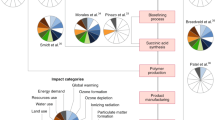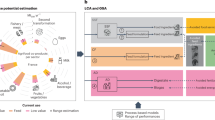Abstract
Purpose
Life cycle assessments of biosuccinic acid (bioSA) report a range of emissions compared to their fossil-based counterparts. Such uncertainty results from multiple factors including different processing options and modeling choices, making it difficult to interpret results and ensure emission reductions. Identifying uncertainty is thus crucial to ensuring the environmental benefits of biomaterials and is a crucial step toward a future bioeconomy.
Methods
Comparing 15 life cycle assessments of bioSA production, factors such as feedstocks, downstream processing technologies, study scopes, coproduct handling, coproduct types, and study locations were assessed to identify the impact of different modeling choices and processing options on the global warming impacts of bioSA. Emissions were referenced to a fossil-derived equivalent product and selected case studies were developed for a more in-depth analysis of the impact of individual factors, such as enzymes, coproducts, and grid location on overall emissions.
Results
Global warming impacts varied across differing processing and modeling factors. BioSA from sugar cane and energy crops consistently showed emission reductions while from corn starch, corn stover, and food waste, bioSA displayed impacts above and below fossil-based production depending on processing and modeling options. Uncertainty in individual factors such as enzyme production was significant, potentially resulting in impacts exceeding conventional fossil-based production. However, coproduct inclusion and handling methods were necessary for several feedstocks to ensure emissions remained lower than the fossil-based route.
Conclusions
This study highlights the importance of identifying and quantifying uncertainties in the global warming impacts of biobased products. Doing so serves not only to ensure emission reduction benefits, but also strengthens trust in LCA studies and encourages more accurate and trustworthy results for policy makers, industrial partners, and LCA practitioners.





Similar content being viewed by others
Data availability
The datasets used to generate the Figures in this study are publicly available in the figshare repository (https://doi.org/10.6084/m9.figshare.23611533). All global warming potential values analyzed in this study from the existing literature are publicly available through the cited references and methods described in the paper and the corresponding Supplementary Information.
References
Adom F, Dunn JB, Han J, Sather N (2014) Life-cycle fossil energy consumption and greenhouse gas emissions of bioderived chemicals and their conventional counterparts. Environ Sci Technol 48(24):14624–14631. https://doi.org/10.1021/es503766e
Ahn JH, Jang Y-S, Lee SY (2016) Production of succinic acid by metabolically engineered microorganisms. Curr Opin Biotechnol 42:54–66
Althaus H, Chudacoff M, Hischier R, Jungbluth N et al (2007) Life cycle inventories of chemicals. Ecoinvent Rep 2
Bechthold I, Bretz K, Kabasci S, Kopitzky R et al (2008) Succinic acid: a new platform chemical for biobased polymers from renewable resources. Chem Eng Technol 31(5):647–654. https://doi.org/10.1002/ceat.200800063
Bello S, Ladakis D, Gonzalez-Garcia S, Feijoo G et al (2022) Renewable carbon opportunities in the production of succinic acid applying attributional and consequential modelling. Chem Eng J 428. https://doi.org/10.1016/j.cej.2021.132011
Bishop G, Styles D, Lens PN (2021) Environmental performance comparison of bioplastics and petrochemical plastics: a review of life cycle assessment (LCA) methodological decisions. Resour Conserv Recycl 168:105451
Bozell JJ, Petersen GR (2010) Technology development for the production of biobased products from biorefinery carbohydrates-the US Department of Energy’s “Top 10” revisited. Green Chem 12(4):539–554. https://doi.org/10.1039/b922014c
Brunklaus B, Rex E, Carlsson E, Berlin J (2018) The future of Swedish food waste: an environmental assessment of existing and prospective valorization techniques. J Clean Prod 202:1–10. https://doi.org/10.1016/j.jclepro.2018.07.240
Choi S, Song CW, Shin JH, Lee SY (2015) Biorefineries for the production of top building block chemicals and their derivatives. Metab Eng 28:223–239
Chrysikou LP, Bezergianni S, Kiparissides C (2018) Environmental analysis of a lignocellulosic-based biorefinery producing bioethanol and high-added value chemicals. Sustainable Energy Technol Assess 28:103–109. https://doi.org/10.1016/j.seta.2018.06.010
Cok B, Tsiropoulos I, Roes AL, Patel MK (2014) Succinic acid production derived from carbohydrates: an energy and greenhouse gas assessment of a platform chemical toward a bio-based economy. Biofuels Bioproducts & Biorefining-Biofpr 8(1):16–29. https://doi.org/10.1002/bbb.1427
Curran MA (2013) Life cycle assessment: a review of the methodology and its application to sustainability. Curr Opin Chem Eng 2(3):273–277. https://doi.org/10.1016/j.coche.2013.02.002
Dickson R, Mancini E, Garg N, Woodley JM et al (2021) Sustainable bio-succinic acid production: superstructure optimization, techno-economic, and lifecycle assessment. Energy Environ Sci 14(6):3542–3558. https://doi.org/10.1039/d0ee03545a
Dunn JB (2019) Biofuel and bioproduct environmental sustainability analysis. Curr Opin Biotechnol 57:88–93
Dunn JB, Adom F, Sather N, Han J et al (2015) Life-cycle analysis of bioproducts and their conventional counterparts in GREET
Gadkari S, Kumar D, Qin ZH, Ki Lin CS et al (2021) Life cycle analysis of fermentative production of succinic acid from bread waste. Waste Manag 126:861–871. https://doi.org/10.1016/j.wasman.2021.04.013
Hermann B, Blok K, Patel MK (2007) Producing bio-based bulk chemicals using industrial biotechnology saves energy and combats climate change. Environ Sci Technol 41(22):7915–7921
ISO (2006) 14044:2006. Environmental management: life cycle assessment; requirements and guidelines, International Organization for Standardization (ISO)
Janssen M, Xiros C, Tillman AM (2016) Life cycle impacts of ethanol production from spruce wood chips under high-gravity conditions. Biotechnol Biofuels 9. https://doi.org/10.1186/s13068-016-0468-3
de Jong E, Higson A, Walsh P, Wellisch M (2020) Bio-based chemicals. IEA Bioenergy
Li X, Mupondwa E (2021) Empirical analysis of large-scale bio-succinic acid commercialization from a technoeconomic and innovation value chain perspective: BioAmber biorefinery case study in Canada. Renew Sustain Energy Rev 137:110587
Maria Ioannidou S, Filippi K, Kookos IK, Koutinas A et al (2021) Techno-economic evaluation and life cycle assessment of a biorefinery using winery waste streams for the production of succinic acid and value-added co-products. Bioresour Technol 126295. https://doi.org/10.1016/j.biortech.2021.126295
Mazière A, Prinsen P, García A, Luque R et al (2017) A review of progress in (bio) catalytic routes from/to renewable succinic acid. Biofuels, Bioprod Biorefin 11(5):908–931
Montazeri M, Zaimes GG, Khanna V, Eckelman MJ (2016) Meta-analysis of life cycle energy and greenhouse gas emissions for priority biobased chemicals. Acs Sustainable Chemistry & Engineering 4(12):6443–6454. https://doi.org/10.1021/acssuschemeng.6b01217
Moussa HI, Elkamel A, Young SB (2016) Assessing energy performance of bio-based succinic acid production using LCA. J Clean Prod 139:761–769. https://doi.org/10.1016/j.jclepro.2016.08.104
Musonda F, Millinger M, Thran D (2020) Greenhouse gas abatement potentials and economics of selected biochemicals in Germany. Sustainability 12(6). https://doi.org/10.3390/su12062230
Ogmundarson O, Herrgard MJ, Forster J, Hauschild MZ et al (2020) Addressing environmental sustainability of biochemicals. Nature Sustainability 3(3):167–174. https://doi.org/10.1038/s41893-019-0442-8
Patel MK, Bechu A, Villegas JD, Bergez-Lacoste M et al (2018) Second-generation bio-based plastics are becoming a reality - non-renewable energy and greenhouse gas (GHG) balance of succinic acid-based plastic end products made from lignocellulosic biomass. Biofuels Bioproducts & Biorefining-Biofpr 12(3):426–441. https://doi.org/10.1002/bbb.1849
Patel M, Crank M, Dornberg V, Hermann B et al (2006) Medium and long-term opportunities and risk of the biotechnological production of bulk chemicals from renewable resources-The potential of white biotechnology
Pinazo JM, Domine ME, Parvulescu V, Petru F (2015) Sustainability metrics for succinic acid production: a comparison between biomass-based and petrochemical routes. Catal Today 239:17–24. https://doi.org/10.1016/j.cattod.2014.05.035
Shaji A, Shastri Y, Kumar V, Ranade VV et al (2021) Economic and environmental assessment of succinic acid production from sugarcane bagasse. Acs Sustainable Chemistry & Engineering 9(38):12738–12746. https://doi.org/10.1021/acssuschemeng.1c02483
Smidt M, den Hollander J, Bosch H, Xiang Y et al (2016) Life cycle assessment of biobased and fossil-based succinic acid
Tecchio P, Freni P, De Benedetti B, Fenouillot F (2016) Ex-ante life cycle assessment approach developed for a case study on bio-based polybutylene succinate. J Clean Prod 112:316–325. https://doi.org/10.1016/j.jclepro.2015.07.090
Valin H, Peters D, Van den Berg M, Frank S et al (2015) The land use change impact of biofuels consumed in the EU: quantification of area and greenhouse gas impacts
Walker S, Rothman R (2020) Life cycle assessment of bio-based and fossil-based plastic: a review. J Clean Product 261. https://doi.org/10.1016/j.jclepro.2020.121158
Weiss M, Haufe J, Carus M, Brandao M et al (2012) A review of the environmental impacts of biobased materials. J Ind Ecol 16:S169–S181. https://doi.org/10.1111/j.1530-9290.2012.00468.x
Werpy T, Petersen G (2004) Top value added chemicals from biomass: volume I--results of screening for potential candidates from sugars and synthesis gas
Zucaro A, Forte A, Fierro A (2017) Greenhouse gas emissions and non-renewable energy use profiles of bio-based succinic acid from Arundo donax L. lignocellulosic feedstock. Clean Technol\ Environ Policy 19(8):2129–2143. https://doi.org/10.1007/s10098-017-1401-6
Acknowledgements
The authors would like to thank the members of the Center for Bioplastics and Biocomposites (CB2) for their discussions and guidance regarding processing options of biobased succinic acid.
Funding
This work was funded in part by the Center for Bioplastics and Biocomposites (CB2) under the project IUCRC-2021-N2-Li/Locklin–Life Cycle Assessment Tool for Sustainable Bio-based Coating Material Design.
Author information
Authors and Affiliations
Contributions
All authors formulated and refined conclusions. J. Dunlap contributed conceptualization, data collection, methodology and formal analysis, and manuscript writing. K. Li contributed funding acquisition, conceptualization, methodology and formal analysis, project administration, and draft revisions. J. R. Schramski contributed formal analysis and draft revisions. G. Li contributed literature review and data collection.
Corresponding author
Ethics declarations
Competing interests
The authors declare no competing interests.
Additional information
Communicated by Guido W. Sonnemann.
Publisher's Note
Springer Nature remains neutral with regard to jurisdictional claims in published maps and institutional affiliations.
Supplementary Information
Below is the link to the electronic supplementary material.
Rights and permissions
Springer Nature or its licensor (e.g. a society or other partner) holds exclusive rights to this article under a publishing agreement with the author(s) or other rightsholder(s); author self-archiving of the accepted manuscript version of this article is solely governed by the terms of such publishing agreement and applicable law.
About this article
Cite this article
Dunlap, J., Schramski, J.R., Li, G. et al. Identifying uncertainty in the global warming impacts of biomaterials: an analysis of biosuccinic acid. Int J Life Cycle Assess (2024). https://doi.org/10.1007/s11367-024-02290-1
Received:
Accepted:
Published:
DOI: https://doi.org/10.1007/s11367-024-02290-1




